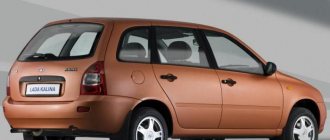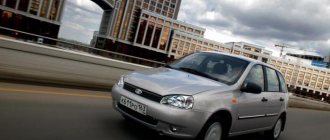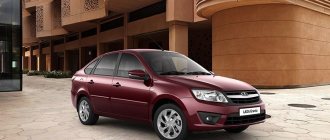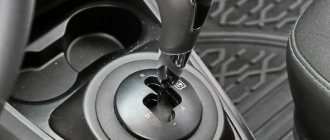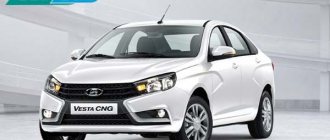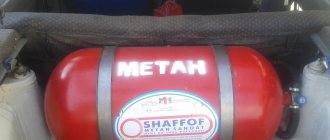"Lada-Kalina" is currently one of the most popular and frequently seen Russian-made cars on our roads. This model has been in production for the 13th year. The first car rolled off the assembly line in 2004, although the development of Kalina began back in 1993. The future new product has been designed and improved for more than ten years - it is not surprising that it has become one of the most anticipated AvtoVAZ models. Now many people own such a car. The Lada Kalina station wagon is especially popular. Reviews from owners are direct confirmation that this is a solid and functional machine. The model is indeed of particular interest, so it is worth paying a little more attention to this topic.
First generation
Before moving on to owner reviews of the Lada-Kalina station wagon, it’s worth briefly talking about the car itself. And we should start with the first generation.
The station wagon, which was assigned the index 1117, was released later than the sedan and hatchback. Its mass production began only in 2007. The car quickly gained popularity due to its capabilities related to cargo and passenger transportation.
Externally, the station wagon looks almost the same as the sedan and hatchback. But due to the monumental stern with a large luggage lid and unique lights, it looks more harmonious and proportional.
This model was offered with the following engines:
- 1.6-liter, 81 horsepower. Acceleration to 100 km/h in 13 seconds. Maximum – 165 km/h. Consumption in the city and on the highway is 9.8 and 6.2 liters, respectively.
- 1.4-liter, 89 hp. The indicators are similar, but the consumption is 1-2 liters less.
- 1.6-liter, 98 hp. Acceleration to 100 km/h in 7.2 seconds. Maximum – 183 km/h. Consumption in the city and on the highway is 11 and 8 liters, respectively.
As for capacity, the station wagon’s trunk can accommodate 430 liters of cargo. The volume can be increased to 500 liters by removing the rear parcel shelf.
Equipment
Good equipment is the first advantage that can be highlighted when reading reviews from owners of the Lada-Kalina station wagon.
The model was offered in three trim levels. The standard included steel wheels, halogen headlights, glazing with ultraviolet protection, bumpers painted in body color, an adjustable steering column, and central locking with remote control.
But that is not all. Also included in the list of basic equipment are front electric windows, door stiffeners, audio preparation, an immobilizer, an alarm system, a driver's kit (jack, wheel wrench, spare wheel), a notification about the need for diagnostics, and also a buzzer for an ignition key left, lights on, rear untranslated transfers.
The next configuration was called “norm”. The car in this version, in addition to the above, also had a mirror in the passenger sun visor, decorative wheel covers, climate control, and an audio system (FM+CD+MP3) with two speakers and an antenna.
In the luxury version, the car was additionally equipped with rain sensors, a curtain in the luggage compartment, an ABS system, a seat belt tensioner, driver and front passenger airbags, rear electric windows, heated seats and mirrors (with electric drive), and also fog lights. By the way, the wheels on the version with this configuration were fitted with light alloy wheels.
Considering all of the above, one can understand why the majority purchased the Kalina in a luxury version. The price difference at that time was approximately 70,000 rubles for a model with an 81-horsepower 1.6-liter engine.
Exterior
The first generation of Lada Kalina was produced for 9 years, so the new product, which appeared in 2013, has already received a radically new modern design with smooth body lines, new lighting equipment and bumpers painted in body color. The new car has a dynamic appearance, improved aerodynamic characteristics, as well as modern, reliable original optics. In general, the car has a successful design that no longer looks archaic compared to its main competitors, budget Koreans and inexpensive European brands.
Subcompact version in use
Now we will talk about the Lada-Kalina 1.4 station wagon. The reviews left by owners about this version fully allow us to understand what this car is like.
Motorists pay special attention to the performance of the 89-horsepower engine. A car with such a unit drives briskly, but the engine loves high speeds, so at the bottom it is somewhat “thoughtful.”
What can you say about consumption? In summer, the on-board computer shows an average of about 6.5 liters per 100 kilometers on the highway (at a speed of 110-120 km/h); when driving around the city, consumption increases to 8.2 liters. With the air conditioner turned on, consumption increases, but not by much - by about 0.2-0.3 liters.
Consumption also depends on driving style. If you move along the highway at speeds of up to 90 km/h, the engine will consume even less than six liters. But in winter, of course, consumption increases. When driving around the city it is approximately 11 liters. On the highway - about 7-8 liters. By the way, owners recommend using 95-grade gasoline, since 92-grade gasoline is difficult to digest.
Owners pay special attention to the dynamics of this car. Compared to early VAZ models, this car is just a spaceship. In fact, it’s a station wagon with dynamics that provide quite comfortable driving around the city. But the reserve of the 1.4-liter engine is sometimes not enough even for those motorists who are not adherents of a harsh driving style. The engine is a compromise, with adequate fuel consumption, allowing you to stay in the flow and even overtake, but without reserve. Although on the highway a car with this engine behaves well. But only if there are no passengers in the cabin and no cargo in the trunk. Otherwise, many people get the impression that they are driving not a car, but a horse-drawn carriage.
Cold engine won't start
If your car's engine does not start, you should know that this is due to reasons related to the temperature conditions of the device. This factor is stabilized quite simply and painlessly, and accordingly, weak points are easily eliminated.
First of all, the car may not start due to a cold engine that stubbornly refuses to warm up. As a rule, such a breakdown occurs during a long period of inactivity in the summer. In winter, everything happens much faster, because the temperature outside is minus.
Cross section of a 1.6i engine: 1 — oil pan drain plug; 2 — engine sump; 3 - crankshaft; 4 — oil filter; 5 - catalytic manifold; 6 — coolant pump; 7 - piston; 8 — oxygen concentration sensor; 9 — laying of the intake pipeline and exhaust manifold; 10 — inlet pipeline; 11 — nozzle; 12 — diagnostic fitting of the fuel rail; 13 - receiver; 14 — bracket for fastening the tip of the cable sheath; 15 — cylinder head cover; 16 — camshaft bearing housing; 17 - camshaft; 18 — crankcase ventilation system hose; 19 — valve pusher; 20 — cylinder head; 21 — bolt securing the head to the cylinder block; 22 - valve; 23 - candle; 24 — cylinder head gasket; 25 — upper compression ring; 26 — lower compression ring; 27 — oil scraper ring; 28 — piston pin; 29 — fitting for installing the oil level indicator; 30 — connecting rod; 31 - flywheel; 32 — cylinder block; 33 — oil pan gasket; 34 — oil level indicator; 35 - oil intake
In particular, the engine oil temperature is compared with the ambient temperature, which should not be the case. The weak points in this case are the coolants. The algorithm of actions for a cold engine is as follows.
- Pull the handle that controls the lock drive towards you, thus opening the hood.
- Take an oil dipstick and check the fluid level in the engine. You should know that ideally the mark should be between o and “MIN”.
- Check the engine cooling fluid level. Ideally it is half the capacity.
- Carefully inspect the engine and the space under the hood. Often the problems lie there. Particular attention should be paid to gasoline and oil drips, as well as brake and cooling fluid leaks. Be sure to check the integrity of the electrical wiring.
- Car malfunctions are more accurately identified when trying to start it, so without closing the hood, you need to get behind the wheel. If it’s raining or snowing outside, it’s best to cover the hood. Before this, you need to check the high-voltage wires on the spark plug coils, since very often faults lie precisely in them. Then you can turn on the ignition, having previously installed the key in it under the number “I”. This factor should lead to the operation of the device for supplying gasoline to the engine.
- The ignition key is turned and the car engine starts. If the attempt is unsuccessful, then the fault lies deeper. In particular, in the starting system, ignition system or engine power supply. In any case, you need to check all options. The video shows all the manipulations. You can watch a video on this problem.
Versions with a 1.6-liter unit
There are more owners of such modifications than people driving station wagons with the notorious 1.4 liter engine. What do they say about them?
Motorists characterize the 1.6-liter engine as a playful, noisy, and quickly gaining momentum unit, which begins to “eat well” after 3000 rpm. The thrust of this engine is more than enough to get moving from idle. But in terms of adding gas you need to be very careful. If you press the pedal to the floor, the wheels will slip. This is especially noticeable when starting on an incline. Gas must be dosed carefully even after switching to second gear.
But, in general, the 1.6-liter engine is capable of satisfying even high-speed enthusiasts. A car with such a unit, of course, is not intended for racing tracks, but the power of this engine is enough not only for everyday driving - the car feels confident on the track.
Consumption, as shown by reviews from owners about the Lada-Kalina station wagon, corresponds to the figures stated in the passport. Moreover, if you choose a gentle driving mode and stick to it consistently, you can further reduce consumption. Many motorists assure: consumption on the highway can be 4.8-5 liters, if you do not overestimate the speed. In the city the figure is stable - 7-8 liters per “hundred”.
Engine overheating, problems with the starting system
Cooling system: 1 — expansion tank; 2 — radiator outlet hose; 3 - inlet hose; 4 - radiator; 5 - steam removal hose; b — radiator supply hose; 7 — electric fan; 8 — electric fan casing; 9 — coolant temperature sensor; 10 — coolant temperature indicator sensor; 11 — throttle assembly; 12 — bracket for the coolant pump pipe; 13 — coolant pump; 14 — coolant pump pipe; 15 — heater radiator supply hose; 16 — heater radiator outlet hose; 17 — exhaust pipe; 18 — coolant pump pipe hose; 19 — thermostat housing
The engine may overheat due to boiling of the engine oil. To eliminate such a malfunction, you only need to start the starter. The motor control system itself will find the optimal way out of this situation.
However, this method cannot be called universal, so if the engine still does not start, then you need to check the above options. A video on this topic might help. You can recognize that the problem lies in the starter by its unnatural behavior. There are five main faults of this component.
- The starter refuses to turn on. Repairing Kalina in this case comes down to eliminating the breakdown in broken contacts, a break or short circuit in the starter electrical circuits, or a malfunction of the element traction relay.
- When you try to start the starter, you hear characteristic clicks that are repeated many times. In this case, it is necessary to start repairing the Lada with the traction relay, or more precisely, with its winding. The reasons may be a discharged battery or loose contact connections of the starter.
- The starter starts but the armature does not work properly. The main reason is a dead battery. In addition, there may be contact failures or breakdowns of the starter traction relay. The culprit may also be simple contamination of the collector.
- The starter and armature are functioning properly, but the flywheel refuses to operate. As a rule, the cause is a loose starter, broken teeth in the flywheel and lever, as well as the drive buffer spring.
- The starter does not work after starting the engine. The reason lies in a malfunction of the starter freewheel or failure of the traction relay. In this case, it is necessary to immediately stop the engine to prevent its permanent breakdown. The experts in the video will tell you and show you what to do next.
It is very difficult to eliminate the above breakdowns on your own. It is best to contact a specialized service station, where they can quickly find and fix the problem.
In road conditions, you can only check the discharge of the battery using a voltmeter, and also pay attention to whether the contacts in the starter circuit are tightly tightened. The video will help you perform this action correctly.
Electronics operation
You can also learn a lot of interesting things about it by reading owner reviews of the Lada-Kalina (station wagon) with photos.
The operation of the air conditioner deserves special attention. Firstly, when you turn it on, you get the feeling that an anchor has been dropped on the asphalt. Management becomes more difficult. Because of this, many turn it on only in weather in which it is impossible without it.
Secondly, the air conditioning works very poorly. Thirdly, in order for it to somehow cope with its task, you need to regularly change the cabin filter, charge it with refrigerant and clean it.
You can also find many comments about the operation of the stove. Here the situation is better. The interior warms up quickly and well, but there is one thing. Side windows become chronically cloudy at temperatures below -20°C. And if in cold weather you direct the air in some other direction, the side mirrors are also lost. So you won’t be able to warm the windows and your feet at the same time. And the stove only works well at outside temperatures down to -30 °C.
Behavior on the road
It is described in detail by many owners of the Lada-Kalina station wagon. Reviews allow us to verify that the chassis of this car is quite acceptable in its characteristics for Russian roads. The car does not roll when turning, but it is not recommended to make sharp turns - it becomes scary. The suspension “swallows” medium-sized holes and bumps, but when passing serious obstacles you need to be extremely careful and reduce speed to a minimum.
The ground clearance of the station wagon is 16 centimeters, but it feels like it is even lower. However, this ground clearance is enough for driving around the city and light off-road.
The car's brakes are good, but somewhat weak. Some motorists changed the pads and fluid in the system, but even this did not achieve the desired effect. Apparently, this is the specificity of the Kalina brakes.
Many people call the seating “stool-like”, but it is more comfortable than in “tens” and “nines” (people who have something to compare with claim this).
Also, many motorists, when talking about this car, note its clear advantage over other models, which lies in its compactness. The station wagon measures 4,040 mm in length, 1,700 and 1,500 mm in width and height, respectively. These dimensions have made the Kalina a small and nimble city car that can easily squeeze through both courtyards and parking lots.
Second generation
In 2013, production of the most affordable Kalina station wagon was launched. This version was already equipped as standard with a driver's airbag, front electric windows, audio preparation, heat-absorbing windows, and electric power steering.
A new unit was installed under the hood of this model - an 8-valve 1.6-liter engine producing 87 horsepower. Its feature was a lightweight connecting rod and piston group.
Why was this model called the most affordable station wagon? Because its price was 330,500 rubles.
A year later, the Lada-Kalina Cross station wagon was released. Feedback from owners about this model makes it clear that it differs from the regular version in appearance, with a stiffer suspension and “longer” gears. This modification also received a ground clearance increased by 2.3 centimeters.
It is also worth noting that with the release of the second generation models, versions with a 1.6-liter 106-horsepower engine appeared. The maximum maximum speed of a car with such a unit is 177 km/h. At the same time, it accelerates to “hundreds” in 11.2 seconds and consumes about 6.7 liters in the combined cycle.
Prices and options
In the base, the second generation Lada Kalina received a driver's airbag, electric power steering, athermal windows, front power windows, audio preparation and daytime running lights. The cost of this car in the basic configuration started from 330 thousand rubles. If desired, the car owner could select various additional options, as a result of which the price increased to 400 thousand rubles.
The Norma's package included two airbags, a USB and Bluetooth interface, ABS and an emergency brake booster. The cost of the Lada Kalina in the Norma configuration, depending on the gearbox and engine, was 350-400 thousand rubles.
The Luxury package included a stability control system, an emergency braking system, aluminum alloy wheels, roof rails, front fog lights, full power accessories, heated side mirrors, and a multimedia system on the central panel with a 7-inch wide LCD display. It was also possible to order the installation of a navigation system, while the cost of a car with all such options with an automatic transmission increased to almost 500 thousand rubles.
About versions with a 106-horsepower engine
As reviews from owners show, the 2nd generation Lada Kalina station wagon has become more functional and technically attractive than its predecessors. In addition, versions with a powerful 106-horsepower engine appeared! It is logical that most car enthusiasts began to buy this version.
And the difference between this engine and previous units is really visible. It is especially noticeable at low speeds. The 106-horsepower engine pulls excellently and is quieter than other engines, even at high speeds. Consumption is not very high - about 10 liters in the city, and about 8 liters on the highway.
The gearbox is cable-driven - the gears are somewhat long, and the clarity is worse than on foreign cars. However, the box is still much nicer than its predecessors.
But what the owners who leave reviews like most about the Lada-Kalina-2 station wagon is the suspension. They note its balance. It “swallows” uneven spots and holes unnoticed. Those who have something to compare with say that even on some foreign cars the suspension is not that good.
Interior
You can’t expect any miracles from AvtoVAZ’s budget model, but at the same time, the interior has improved significantly; the top versions even have a multimedia screen on the central panel. The plump steering wheel fits perfectly in the hands, the instrument panel is ergonomic, there is a small digital display between the two main instruments, which displays various parameters regarding engine operation. The quality of finishing materials has improved somewhat, primarily in regards to non-staining and wear-resistant seat upholstery. The plastic has become more pleasant to the touch, but the build quality is still low, so unpleasant creaks of plastic panels are not uncommon.
Automatic transmission
It is impossible not to pay attention to the automatic version when studying the owner reviews left about the car in question. The Lada Kalina station wagon with automatic transmission is an excellent option for the city. This is what all the people who purchased it say. It’s especially pleasant to be behind the wheel of such a car after a manual transmission. But! If you carefully study the owner reviews of the Lada-Kalina station wagon with an automatic transmission, you can conclude: people who switched to it from a foreign car with an automatic transmission are not delighted. However, others advise just driving for a few days to get used to the specifics of Russian-made AMT.
And the peculiarity of the VAZ automatic transmission is the periodic illogical switching. Sometimes gears change at moments when the driver himself would not do this. But still, the majority is of the opinion that the automatic transmission in this car is not bad. Paired with the engine it works great, providing good dynamics. And there are no jerks, which is the most important thing.
However, the owners of the Lada-Kalina-2 AMT station wagon note some shortcomings in their reviews. It consists of an inconveniently located dipstick for checking the oil level in the gearbox - under the air filter.
What about service? Official information says that this “automatic” (Jatco JF414E) does not need it. But motorists recommend updating the oil every 30-45 thousand kilometers using the partial replacement method (without removing the pan).
Flaws
They are worth talking about separately. The shortcomings in the reviews of owners of the Lada-Kalina station wagon are often mentioned. They concern basically the same points.
- “Crickets” in the cabin are the first negative, the mention of which is found in all reviews of owners of the Lada-Kalina station wagon. The 1st and 2nd generations are guilty of “crickets”. The use of cheap materials in finishing has an effect. Often there is a strange clanging sound from somewhere under your feet and the rattling of the gearshift lever. Many people eliminate them using electrical tape, periodically tightening the nuts and screws.
- Unreliable spark plug modules installed on a 16-valve engine. The replacement frequency is once every 10,000 kilometers, and this is too often.
- Sensors Unreliable, just like the notorious spark plug modules.
- Light bulbs. To replace them, you need to try hard and spend a lot of time. Perhaps owners of flexible hands have an easier time.
- Capacity. Questions to this point are found in every review from owners of the Lada-Kalina station wagon. The disadvantages listed above, in principle, do not cause surprise, except for the capacity. After all, this is a station wagon, which means there should be enough space in it for both passengers and large cargo. But no. Even according to the passport, the maximum permissible load is limited to 475-500 kilograms. So the station wagon here is just a name and a body, but not functionality. And the owners of the Lada-Kalina station wagon who leave reviews call this the main drawback.
Advantages
Many advantages of this car have already been mentioned above. But now it’s worth summarizing them.
- A significant advantage is the low price of the car. It is mentioned in all reviews of owners of the Lada-Kalina station wagon. Luxury equipment - and it is inexpensive. The price of the new model with maximum equipment is 510-580 thousand rubles. (the exact cost depends on the dealer, stock availability and other nuances). And this is the cost of a model with an automatic transmission and a 106-horsepower engine. And so the price of the most budget version with the weakest engine starts from 385,000 rubles.
- Economical operation is another advantage of this car. This does not only mean consumption. It is also taken into account that spare parts for this machine can be bought literally anywhere. Body work, by the way, is also inexpensive. And if the need for repair arises, you can fix the problem in the middle of the road or in a garage.
- Quality. There is one last important plus that I would like to mention. In comparison with old VAZ models, Kalina really pleases with a decent level of assembly. This, by the way, is one of the main reasons why it has become so popular.
Disadvantages of the second generation Lada Kalina
Most car owners note that the body is not very resistant to corrosion, which was a disaster for almost all domestic cars. After just a few years of using the car, the first traces of rust appeared, which gradually spread throughout the body, forcing expensive repairs and repainting of the car.
Another weak point of the second generation Lada Kalina is the injector, which often became dirty, after which it was necessary to take the car to a service center. The car turned out to be quite demanding on the quality of gasoline, so one refueling with questionable fuel could lead to serious malfunctions.
The gearboxes on this car, both manual and automatic, were quite reliable. Buyers were also offered a version with a robot; this transmission was not very successful, so it was not in high demand. The first problems with the robot began literally twenty to thirty thousand kilometers after the vehicle began operating.
12.02.2021
